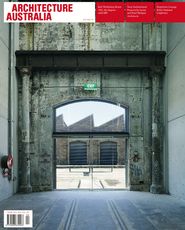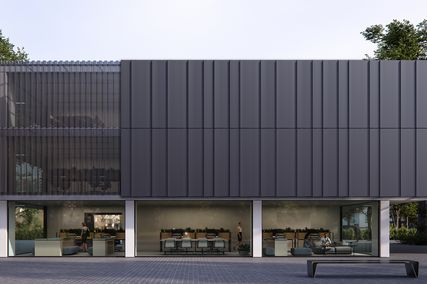PHOTOGRAPHY PETER CASAMENTO
A DAY IN THE OFFICE
ANTHONY BURKE
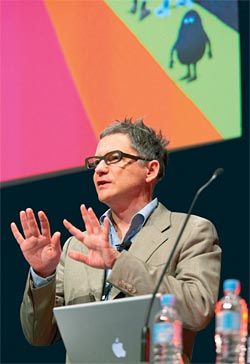
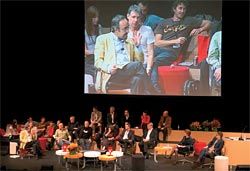
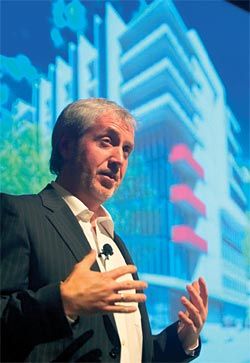
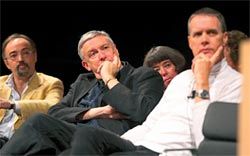
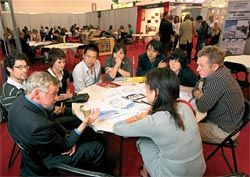
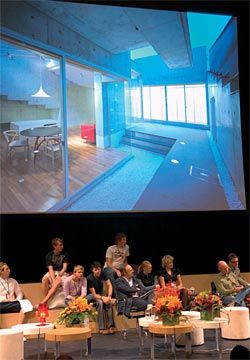
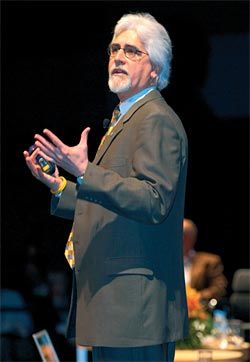

Perhaps as a reaction to last year’s future focus, this year’s RAIA conference was remarkable for its conservatism. The participatory mood intended by director Timothy Hill – with an emphasis on the “plain, professional garden variety”, which we were constantly reminded of both in the catalogue and at the event – was supposed to leave us feeling lighter, collegial and refreshed. It left me, at least, with jet lag. Leaving “with less baggage than when you arrived” was the goal, writes Hill, strangely linking the worst aspect of air travel (lost baggage) to a psychotherapeutic agenda that underpinned most of the conference sessions. For the duration of the conference, I stayed in the departure lounge and waited for take-off.
Ambitions for the conference were laid out in a review by Paolo Tombesi of the 2006 conference in Sydney (“Radar Conference: Future Past”, Architecture Australia vol 95 no 4, July/Aug 2006). In contrast to the stars brought in to inspire in the Sydney version, Hill’s goal was to treat the conference like a day in the office. While this is a questionable analogue for such an important annual event, the altruism of the conference ambitions needs to be acknowledged. Frank, plain speaking and an attempt at inclusiveness are laudable goals, especially on this scale. However, I am troubled by the idea of leaving behind the “why” of architecture in favour of the “what”, as Hill suggests (“Radar Opinion”, Architecture Australia vol 95 no 6, Nov/Dec 2006). This effectively reduces the scope of the discipline to the production of buildings rather than celebrating and engaging with rich complexity at a time when many architecture forums consider the discipline to be expanding. Issues such as the growth of global practice, creative sustainability, technological integration and new forms of collaborative practice are all expansive subjects on which Australian architects have much to contribute.
The conference started promisingly, with the pronouncement of the death of the hero. Hill managed this immediately, with a deft turn of his acerbic tongue in his introduction to the departure lounge, to much deserved applause. With the death of the hero, however, comes the instalment of a replacement regime, which was presumably what we were there to discuss. By championing the everyday and attempting to develop threads of discussion immediately useful for “closing the gap” between the inspiring but removed star-chitects and “reality”, the organizers set up the conference as a contrast to last year’s event, the first of many binary positions around which the conference was intentionally and unintentionally structured.
The conference struggled with the contradiction between intentions and structure. In spite of the momentum in many interesting Australian practices, the conservatism of the conference was most noticeable in the continual reinforcement of party lines based on the conference’s two streams – the technologists on one side of the river and the design types literally on the other. The structural entrenchment of these thankfully outdated stereotypes was reinforced by the general discussion from the podium in the departure lounge, missing the obvious first step towards a broad and creative conversation that engaged the complex and the collective.
For all the generous ambitions of inclusion, the prescription of boundaries through continual promotion of well-understood binaries continued in the organization of the sessions, effectively excluding a more interesting negotiation of the uncertain middle ground. Tough vs. tender, corporate vs. studio, the academy vs. practice, Sydney vs. Melbourne (please can we get over this), and perhaps the most tiresome of all, us (architects) vs. them (the mean old bureaucratic authority structures and generally undeserving and illiterate public), the last binary championed by Angelo Candalepas in a melodramatic presentation in the studio session. Welcome back the hero–antihero logic that was supposedly just dismissed.
The difficulty of the structural impasse notwithstanding, the reframing of design research by Mark Burry and his work at RMIT, Chris Bosse and Mark Dytham, the Tezukas’ presentation of their poetic pragmatics and the session rewarding Enrico Taglietti on a deserved gold medal were standouts of international professionalism. While Taglietti the elder statesman and Peter Corrigan, who introduced him, barely concealed their frustration with the RAIA and the awards system itself, the point at which the conference came closest to exploring the agenda of new practice models was summarized by Mark Burry’s students in the RMIT-embedded PhD programme. Mark concluded, “This is the case for the role of research in practice, and the case for research being taken very seriously.”
Although it was the final session, Crossing the Streams was the venue where a real discourse was able to begin, but could not quite find enough velocity for take-off. Participants tackled the assumption that the discipline is a static cannon, and a door was opened, just a crack, to an engagement with the evolution of the discipline itself and its new possibilities. The growth from easy binaries to integrated complexity is perhaps the single most defining characteristic of our times, as others from Bruce Mau to Noam Chomsky have articulated. Rather than attempting to lighten our load and return to the garden variety, the last session offered a moment when addressing that was possible.
If next year’s conference can build on the promise of the last session, the scope of an active Australian professional voice and its relation to the international vitality of the moment may perhaps even fill us with enough intellectual resources and energy to sustain our everyday practices in the process.
Anthony Burke is a senior lecturer and director of Masters of Digital Architecture at the University of Technology, Sydney.
CROSSING THE STREAMS: BUILDING INFORMATION MODELS VS. ARCHITECTURAL DESIGNPETER RAISBECK
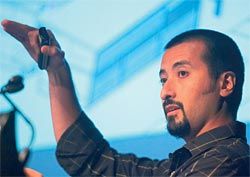
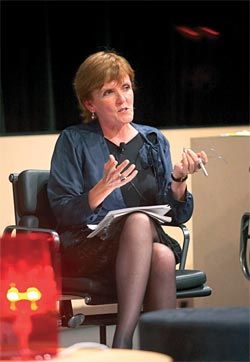
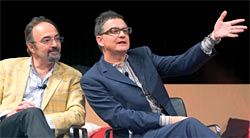
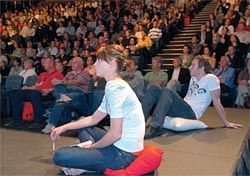
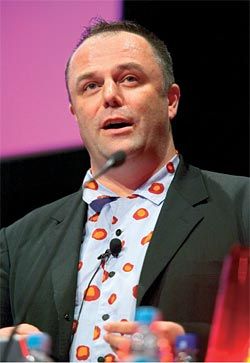
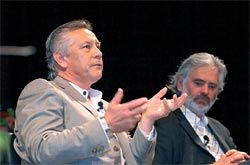
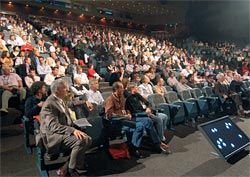
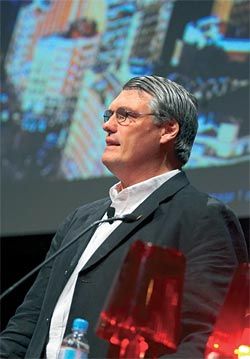
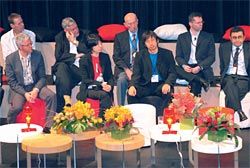
Architects these days seem to be relaxed and comfortable, after years of sustained economic growth in the building sector. Perhaps this is why the RAIA’s 2007 national conference featured an airport-style lounge suite as its central prop. As befi tting architects, the suite revolved around a 1970s-style airport lounge stage set. These Departure Lounge sessions were ably hosted by the conference’s creative director, Timothy Hill. A Building Information Models (BIM) stream ran in parallel, organized by John Mitchell, a consultant and chairman of International Alliance of Interoperability, now sensibly rebranded as the BuildingSMART Australasia group.
These two streams diverged from the style of previous conferences, which, it was said, promoted celebrity architects at the expense of ordinary, economy-class architects. Thus, at its outset, this conference offered a new format and approach. According to Timothy Hill, the Departure Lounge sessions were intended to be conversational in tone, leading to stimulating improvised discussions. He hoped it would be like “just another day at the office”, and that we would all come away feeling lighter, with “less baggage”.
The conference’s version of the taxiing to the runway ritual included a number of SONA activities and organized tours of Melbourne architecture. The SONA Supatute for students on the first day of the conference was a success and was attended by many of Melbourne’s practitioners, design academics and architecture students from around Australia. It was the architectural studio version of speed dating and could certainly be repeated in the future. After these events I was disappointed not to witness any Ralph-Fiennes-like moments at the stratospheric heights of the 89th floor of the Eureka Tower during the conference’s opening party. Nevertheless, the view and the presence of Justin Madden, the Victorian planning minister, reinforced the fact that Melbourne believes in the importance of architecture to its image.
This was followed by what was half-ironically billed by SONA as a students-only event, described as a Special Lecture by a Mystery Guest entitled “Not Melbourne” (professionals admitted only by approval of the speaker). The pilot on this leg turned out to be the Melbourne architect and presumably SONA cult figure Michael Markham, who presented much of his work from the last ten years. I enjoyed this event and later wondered if the Departure Lounge would have been a lot more interesting if Markham had received a boarding pass to the stage, along with a few more architects from Melbourne’s architectural subculture.
While the conference seemed to explicitly eschew parading celebrity architects, there was still a sense that for architects – or a few architects, at any rate – a jetsetting lifestyle can be aspired to. In session four on the Friday evening, Mark Dytham’s lecture was slick and entertaining. His work, as with much that comes out of the Royal College of Art in London, seems to blur the line between architecture, global advertising and product design. Indeed, the Pecha Kucha model he and Astrid Klein have invented and promoted might be something to include in future RAIA conferences.
Also of note was the video-linked session with Benedetta Tagliabue, which worked well and points to the possibilities of videoconferencing for future events.
In session three Chris Bosse’s work with PTW in China was an excellent presentation of a unique project.
Ingrid Richards from Cox Rayner Architects was positioned in the same session, and this was a good contrast between architects and projects. Unfortunately, the session didn’t live up to some of the questions it intended to tackle, as set out in the conference programme notes, such as “Are architects part of the intelligentsia or just providers to the national perspective project?” I would have liked to learn more about how both these architects manage to survive in practice.
Session three featured another striking contrast between two different types, and styles, of practice.
Timothy Hill began by arguing that architects should get over the architect-as-hero model of practice in favour of a more collaborative approach. Surprisingly, Angelo Candalepas then presented the audience with a speech about the horrors of battling planners and bogan clients. This was followed by a slideshow of his work with a Bach chorale soundtrack as background music.
Then Annabel Lahz and Andrew Nimmo spoke about value managing architectural projects. Again, some of the critical questions about the differences between these two practices could have been asked. I wondered how Angelo Candalepas’ exquisite hand-drawn sketches and operatic slideshow would have fared in the BIM sessions across the Yarra.
Carey Lyon, then RAIA National President, noted at the opening party that the inclusion of the BIM stream brought both architects and a realm of knowledge to the conference that would not normally be in attendance.
David Sutherland from Fender Katsalidis gave an excellent introduction to BIM issues, as did Marko Kivisto from Finland, who described the use of BIM in the Helsinki Music Centre. However, the conference may have been served better by avoiding the evangelical rhetoric that is often associated with new technologies.
I am a BIM sceptic. The dream of interoperability has been around for some time (the Australian chapter of the Interoperability Alliance was founded in 1997) and considerable amounts of money have been spent on interoperability research. Despite the CSIRO and the CRC for Construction Innovation championing the development of the IFC standards, in the words of Led Zeppelin, the song remains the same. Frustratingly, the uptake of the IFC tools has been slow and the technology transfer culture needed to make interoperability a reality in the property and construction industry still remains a dream. Perhaps this is because software companies will never agree to open standards. That’s certainly the situation in the Building Automation Systems market, where interoperability is at a stalemate due to a pitched battle between the LonMark and BACnet standards.
As Marko Kivisto noted, there are more problems with transforming data across platforms, differences in proprietary software and new technologies achieving productivity gains than the BIM hype suggests.
Architects should consider whether the software products, so much a part of practice, are really making a difference to the built environment. Each architectural practice is unique and industry-wide research into how practices manage their current software and IT systems needs to go beyond a one-size-fits-all solution.
For the engineers, software developers and architectural technologists who have led the charge for interoperability in both America and Australia, innovation is only ever seen in simplistic terms of creating faster, cheaper, less expensive and more predictable results. In the interoperability world view, strategic and conceptual design, what architects do best – the creation of complex space in the private and public realms – is boiled down to problem solving and spatial optimization. For architects, architecture is more than just space utilization, code checking and coordinating projects across consultancy disciplines.
This is why I find it hard to get excited about BIM and Facilities Management research. Alarmingly, BIM may be just another way for the value of architectural design to be instrumentalized, commodifed and bargained away. Architects shouldn’t forget that within the building sector they are the only discipline able and trained to create, visualize, represent and coordinate space.
Architects need to think more strategically about technology. They need skills in evaluating new information technologies and software products as they emerge. They need to understand more about how the software development process works. As software products and solutions proliferate, architects need to consider how they can use technology for their own competitive advantage rather than be told to adopt the newest snake oil paradigm. The BIM stream only partly addressed these issues. Instead of being urged to draft BIM-style in our architecture schools, we should be teaching architects the strategic and entrepreneurial skills needed to evaluate as well as become involved in the invention of emerging technologies.
Unfortunately, the two conference streams were physically separated by Melbourne’s Yarra River. The BIM sessions were held in the Exhibition Centre and the Departure Lounge was in the Convention Centre.
The separation seemed to be intellectual as well, and the conference would have benefited from a more violent crossing of these streams. Jenny Brockie’s session was billed as the moment when the streams would cross, connecting the “world of technology” and the “world of reflection”, but unfortunately the old, all too relaxed and comfortable divisions of academic versus practitioner and technologist versus designer emerged instead.
When the Ghostbusters cross the streams of their weapons in the first Ghostbusters movie, the fictional ancient Sumerian god Gozer is destroyed and the world is transformed for the better. Consequently, Bill Murray (aka Dr Venkman) gets to hang out with Sigourney Weaver and the Ghostbusters can continue practising.
Deliberately crossing together a few more streams of knowledge in the conference mix might have allowed something more to emerge. The conference format could easily have included discussions about the use of software as a strategic tool for architects (as compared to simply an operational one), global competition in architectural services, intelligent cities, sustainability in the face of devastated ecosystems, new modes of architectural language and aesthetics, and discussions that might help to uphold the role of architects in the new procurement methods.
Airport departure lounges are borderlands – neat, homogenous, placeless spaces where both national and personal identity is elided. These are rarely places where stylistic metaphors are eclectically mixed and streams deliberately crossed. Nevertheless, creative director Timothy Hill adeptly avoided all of the negative connotations attached to departure lounges. His vision for the conference should be highly commended because it developed a subtle and distinct formula for future RAIA conferences. These should continue to follow this format but be less prosaic in the way that the architectural future is tackled.
As one small practitioner noted, three days out of the office is a significant commitment for a conference (even if one of those days is the Sabbath). When you get back to the office you want to feel inspired and have up your sleeve a whole lot of new kooky architectural ideas that you can think about, try out and inflict on your clients. Like any holiday overseas you want to come back through Customs with new fashion items that might just work. This is because if architects are to triumph over Gozer, then they need to cross the streams more often to confirm their place as the property and construction industries’ leading innovators.
Dr Peter Raisbeck teaches architectural practice at Melbourne University.

